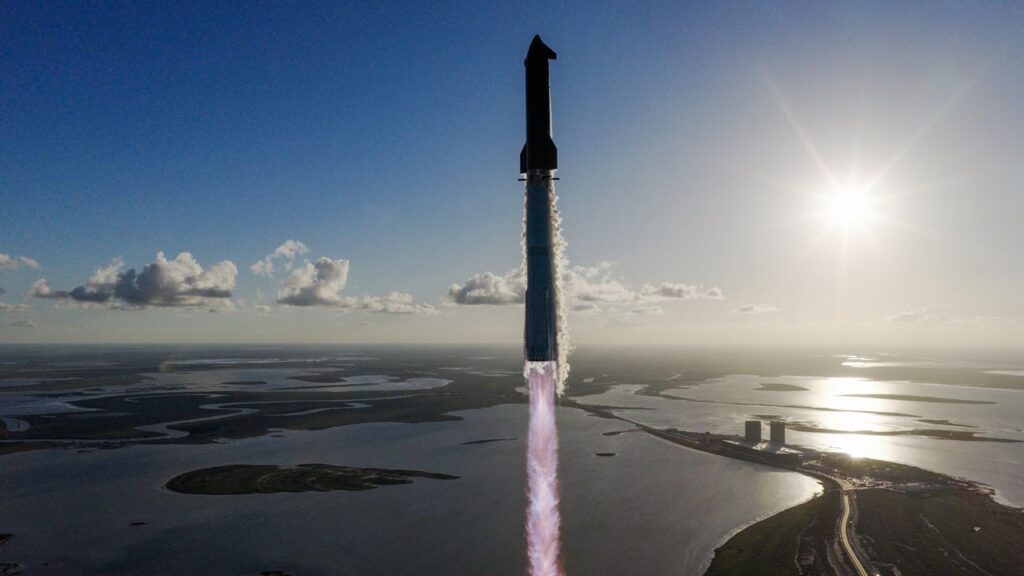
On October 13, 2023, SpaceX successfully launched the 11th test flight of its Starship megarocket from its Starbase site in South Texas. This milestone flight marked the completion of a suborbital journey for the 403-foot-tall (124 meters) rocket, demonstrating significant advancements in the Starship program. Both components of the rocket—the Super Heavy booster and its upper stage, known as Ship—returned to Earth for precise splashdowns, with Ship successfully relighting one of its engines and deploying eight dummy payloads.
This flight was particularly notable as it represented the final launch of the Starship’s “Version 2” variant. Following the successful launch, SpaceX confirmed plans for the next generation of Starship and Super Heavy, indicating that multiple vehicles are currently under construction and gearing up for testing. According to the company, the upcoming iteration will facilitate the first orbital flights of Starship, operational payload missions, and propellant transfer, aiming for a fully reusable vehicle capable of servicing Earth orbit, the Moon, Mars, and beyond.
Developments in Starship Version 3
The next evolution, known as Starship Version 3 (V3), is expected to be about 5 feet (1.5 meters) taller than its predecessor. While V3 will visually resemble Version 2, significant upgrades are being made “under the hood.” During the Flight 11 launch webcast, SpaceX spokesperson Dan Huot highlighted that the V3 Ship’s propulsion system has been revamped to incorporate Raptor 3 engines, a more powerful version of the engines that currently power both stages of Starship.
The enhancements also include energy storage upgrades and numerous avionics modifications that will enable longer-duration missions. Notably, new docking adapters will be introduced, crucial for in-space propellant transfer, a key capability for deep-space missions. SpaceX plans to demonstrate this capability in the coming year.
In a deep-space context, the Ship upper stages destined for the Moon or Mars will launch with minimal propellant to maximize payload capacity. Consequently, they will need to rendezvous with tanker ships in Earth orbit to refuel. The V3 Super Heavy will feature a redesigned fuel transfer tube, allowing for efficient delivery of cryogenic liquid methane and liquid oxygen to its Raptor engines.
Innovations and Future Goals
Additionally, the new Super Heavy boosters will come equipped with an integrated hot stage, increased venting capabilities, and designs that enhance reusability. The hot stage refers to the moment when the Ship begins firing its engines while still connected to the booster, optimizing the launch process.
SpaceX has also made adjustments to the grid fins on the V3 Super Heavy, reducing their number from four to three while increasing their size by 50%. These larger fins will not only aid in steering the booster back to Earth but will also be utilized for lift and catch operations. The Starship launch tower’s “chopstick” arms will play a crucial role in lifting and catching both the Ship and Super Heavy during their launch and return phases.
All eleven Starship test flights have originated from the Orbital Launch Mount 1 at Starbase. This particular launch pad will undergo renovations to support Starship V3, including the installation of a new launch mount and flame trench system. Until these upgrades are completed, SpaceX will conduct launches from Pad 2, which is expected to be operational shortly.
Looking ahead, Starship V3 is poised to take on missions to Mars, with ambitions to launch a small fleet of uncrewed Starships to the planet during the next available window in late 2026. This timeline aligns with the interplanetary launch opportunities that occur approximately every 26 months.
SpaceX has even loftier aspirations for the long term, planning an even larger Starship iteration that will stand 466 feet (142 meters) tall and feature 42 Raptor engines. This Version 4 is slated for a potential debut in 2027, coinciding with NASA’s Artemis 3 mission, which aims to land astronauts on the Moon for the first time since the Apollo era. The upper stage for this historic mission will also be a Starship variant.
As SpaceX continues to push the boundaries of space exploration, the advancements made with Starship V3 and beyond promise to reshape the future of human travel beyond Earth.







